Cars
"I got a '72 white Suburban that no one in the family will ride in.
My vehicles have always been humiliating for the kids.
This one, it's like a motel, and they even complain about this.
I say, "You're nuts. You could live in this car!"
Cars have always been a significant part of Waits's imagery. Car brand names where mentioned in songs and monologues throughout his entire career. Which cars did Waits drive himself? What did they look like? And where did they occur in his lyrics? Here's a list of cars Waits is said to have had. Keep in mind, Waits is a compulsive (yet hilarious) liar, so some of them (probably early 1970's) might have been completely made up.
1955 Buick Special (early 1970's)

The Buick Special was produced by the Buick Motor Division of General Motors, Flint, Michigan/ USA. By 1955, the Buick Special was one of America's best selling automotive series. Buick Specials are easily identified - the model range had three "ventiports" (bulletholes) while senior Buicks had four
"...But I've got them "So long, I'll see you cause my Buick's outside waiting" blues..." ("So Long I'll See Ya". Early Years, 1991. Recorded: July - December 1971, Los Angeles/ USA)
Tom Waits (1999): "My first car cost me $50. It was a '55 Buick Special. Q: Did it run? TW: Oh God yes. Swing low, sweet chariot. It was just a... boat." (Source: "Gone North, Tom Waits, upcountry" by Robert Lloyd. L.A. Weekly: April 23-29, 1999)
1952 Buick Special (early 1970's)
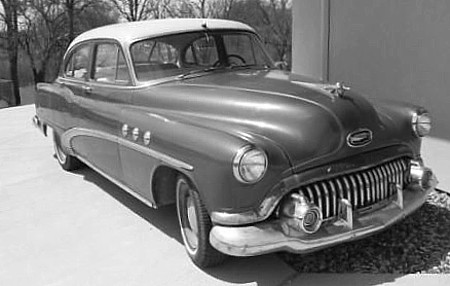
Jerry Yester (2007) on Waits’s car, ca. 1973: “When [producer] Jerry Yester helped Waits find a beautiful 1952 Buick, within two weeks it had been reduced to a trashmobile. "Every wrapper was still in the car, and he kind of reveled in that," Yester says. "He said, 'A car is like a suit. It's gotta fit real well... Sometines Waits preferred simply to shoot the breeze over a beer or three, seated in a new 1952 Buick that was swamped with newspapers and candy wrappers. "He liked to buy a six-pack of Coors and go park somewhere and just talk "' (Source: Jerry Yester interview June 8, 2007 as quoted in “Lowside Of The Road: A Life Of Tom Waits" by Barney Hoskyns. Faber/ Broadway, 2009)
1955 Buick Century (early 1970's)
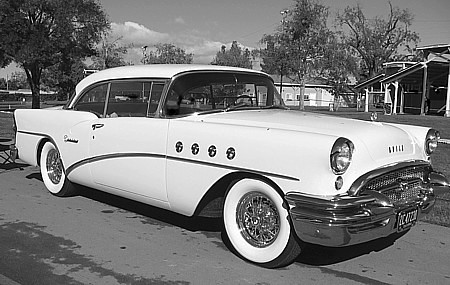
Buick Century is the model name used by the Buick division of General Motors for a line of full-size performance vehicles from 1936 to 1942 and 1954 to 1958, and from 1973 to 2005 for a mid-size car. In 1954, Buick reintroduced the Century using the formula of mating the smaller, lighter Buick Special body to its largest and most powerful 322 cubic inch V8 engine with the intent of giving Buick a performance vehicle. In 1955, the California Highway Patrol placed a large fleet order for Century 2-door sedans, a body style unavailable to the general public
1958 Buick Super (early 1970's)
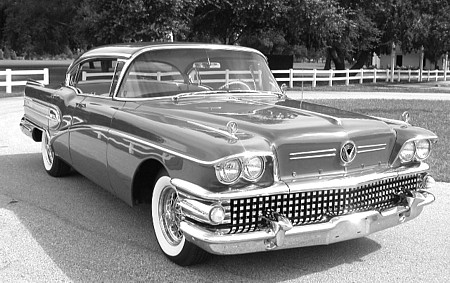
The Buick Super was a full-sized automobile produced from 1940-1942, and from 1946-1958. It was on Buick's longer wheelbase shared with the Roadmaster. It and the Roadmaster were replaced by the new Electra in 1959. The car was relatively quick, able to achieve speeds over 90 miles per hour with its automatic transmission which, rather than changing through gears, simply changes the gear ratios on the fly. The car had 2 splits in the rear windshield although the front was a one-piece and had a nice curve. Models also came with an AM radio and the antenna could be adjusted via a round knob in the front center above the windshield
"...You know I had... let's see I had... four Buicks, loved 'em all..." ("The Pontiac". Smack My Crack, 1987)
Tom Waits (1975) introducing On A Foggy Night, "Nighthawks At The Diner", 1975: "Well, I think it's about time I took you on an improvisational adventure into the bowels of the Metropolitan region. Looks like a bona fide high voltage decked out in full regalia Angelino audience, driving in Subarus, Pintos, Malibus, Oldsmobiles. A small suburban community. This is kinda 'bout two thirty in the morning. You been standing on the corner of 5th and Vermouth, and you climb into the helm of a 1958 monkey-shit brown Buick Super, and you're on your way home. A luxury automobile, bought at Dollar Bill's Easy Autos for next to nothin'. You're cruisin' along, everything's goin' fine"
1955 Buick Roadmaster (early 1970's)

The Roadmaster was an automobile built by the Buick division of General Motors. Roadmasters produced between 1936 and 1958 were built on Buick's longest wheelbase and shared its basic structure with senior Oldsmobiles. Roadmasters are distinguished, from the more pedestrian Buick Specials, by the chrome "gravel shields" between the rear wheel arches and rear bumper. In 1959, Buick introduced a model range that represented a significant shift in its body design, and the Roadmaster was renamed the Electra
"...Well, my time went so quickly I went lickety-splitly out to my ol' fifty-five..." ("Ol' '55". Closing Time, 1973)
"...Well, Eddie Grace's Buick got four bullet holes in the side..." ("Kentucky Avenue". Blue Valentine, 1978)
Tom Waits (1974) introducing Ol' '55: "This a about a '55 Buick Roadmaster. I don't know if there's any real bona fide Buick owners out there tonight. But my goodness, that's an automobile that I swear by. It's a car that's seriously as slick as deer guts on the door knob. Climb aboard one of those suckers, make you feel like a new man. And uh... I always had these cars that I bought for like a hundred and twenty-five dollars. You sink 'bout thirty-five hundred into them, and you sell 'em for twelfe fifty or so. [A lot of noise adjusting the microphone] Rattle like a damned sewing machine... And eh... I stuck to the Buick line for several years. I had two Specials (...) and I had a couple of Centuries, finally I had a Super. And then I finally picked up on this Roadmaster, and lucky to get it! So this is called 'My Ol' '55'." (Source: Passims, Cambridge, November 10, 1974)
Tom Waits (1975): "That's where the mile of cars is, that's where I got snookered in a deal for $125, I bought a 1955 Buick Roadmaster down there. The Roadmaster didn't have fins, the body was a little more sleek, it was a pioneer GM product with the Dynaflow hydramatic transmission, a leviticously deuteronymous catastrophe sort of automobile, it was kind of a scenic cruiser for cross country family outings and that sort of thing, really gripped the road. It lasted for 3 years, I sunk $3,500 into it over a period of 3 years, I sold it for 12 bucks, I had it parked out in front of a cleaners, the brakes went out and I had several parking tickets and a number of moving violations in the glove compartment and I'd been cited and they had stacked them up in a little envelope right underneath the wiper and I couldn't do anything else but call Ace Wrecking and have them tow it away - so I bought another one." (Source: "WAMU radio interview", WAMU Radio Washington, DC. April 18, 1975)
1965 Ford Thunderbird (early 1970's)
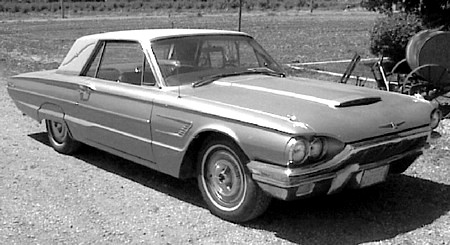
The Thunderbird ("T-Bird"), is an automobile manufactured by the Ford Motor Company/ USA. When introduced, it created the market niche eventually known as the Personal Luxury Car. Evoking the mythological creature of Indigenous peoples of North America, the Thunderbird entered production for the 1955 model year as a sporty two-seat convertible. Unlike the Chevrolet Corvette, it was not marketed as a sports car. Rather, Ford created a new market segment, the Personal Car to position it. For 1964 the Thunderbird was restyled in favor of a more squared-off appearance, which was mostly evident when viewing the car from the side or rear. Both The V8 engines were paired with a 3-speed automatic transmission
"...Maybe you're standin' on the corner of 17th and Wazee Streets. Out in front of the Terminal Bar there's a Thunderbird movin' in a muscatel sky..." (Nighthawk Postcards, Nighthawks At The Diner. July 30/31, 1975)
Tom Waits (1974): "I drive a 1965 Thunderbird that needs a valve job and at least 4 quarts of Penzoil a week and gets 4 miles to the gallon on a long distance, the trunk is busted. And I have 3 warrants on traffic violations in the Los Angeles Metropolitan area alone" (Source: "The Heart Of Saturday Night press release". October, 1974)
Folkscene (1975): "What happened to the Thunderbird you used to talk about? Tom Waits: "I just parked it. I'm gonna use it for an office. It doesn't run much. It's kind of monkey shit brown and in terrible condition - I got in a 4 car pileup before I left town in Vermont in the rain. I was responsible. My first accident, I was out doing about 25 - the traffic - you know how the lights come down, they say they're all stacked up - but it looks like everybody's moving smoothly cause of the lights and the whole rainbow blur effect on the street and James Brown's Papa's Got A Brand New Bag just came on the radio and I was going crazy out of my mind. So it was worth getting in an accident over. First time I heard that song." (Source: Folkscene 1975, with Howard and Roz Larman (KPFK-FM 90.7) Source: audio tape. Date: Los Angeles/ USA. January 12 (February 13?), 1975)
1956 Ford Mercury convertible (early 1970's)
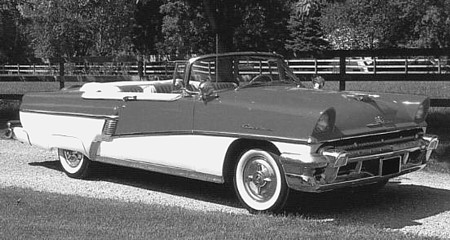
A convertible is a type of automobile in which the roof can retract and fold away, converting it from an enclosed to an open-air vehicle. Mercury is an automobile marque of the Ford Motor Company/ USA. Mercury's heyday was in the 1950's, when its formula of stretching and lowering existing Ford platforms was very successful. The Ford Mercury Montclair was a full size automobile produced 1955-1957
"...And the Mercury was runnin' hot and we were almost out of gas..." ("Jack & Neal". Foreign Affairs, 1977)
"...Bring me the gear shift knob from a 49 Merc. Lay down here beside me let me hold you in the dirt..." ("Wrong Side Of The Road". Blue Valentine, 1978)
1959 Volvo (mid 1970's)
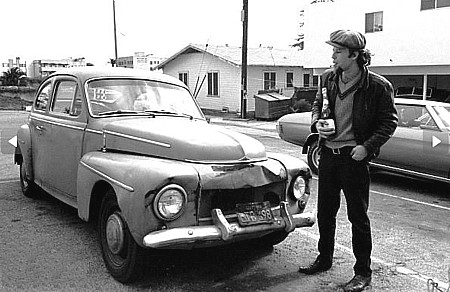
Waits and his 1959 Volvo PV544 (Mark Sullivan/ LIFE, 1974).
The Volvo PV (with its distinct "sloped" back) was a series of two passenger car models (PV444 and PV544) made by Volvo from 1947 to 1965. The PV544 was produced 1958–1965. During the 1960s, the PV544 lived on in relative anonymity with relatively few production changes every year but it still had a faithful customer base. That the car was beginning to feel old-fashioned was well-known at Volvo and was a problem for the company: "Above all the Volvo PV544 is a practical car. Volvo’s most attractive appeal lies in its solidity and its quality in every single respect. There is nothing slapdash or under-dimensioned about any part of the car, and that is more than enough to compensate for any perceived lack of glamour.”
Tom Waits (1999): "Somewhere in there I had a '59 Volvo" Q: You don't strike me as a Volvo guy. TW: "No, it wasn't me, but somebody was trying to get rid of it, and he wanted 5100 for it. And he was a cop, so I said, "I'll take it," Had that sloped back, that scoliosis back" (Source: "The Man Who Howled Wolf" by Jonathan Valania. Magnet magazine June-July, 1999)
1954 black Cadillac Fleetwood sedan (mid 1970's)

The Fleetwood name was used on the top of the Cadillac line. In 1954 Cadillac had two Fleetwood series: the 'Sixty Special Fleetwood" (based on Series 62) and the "Series 75 Fleetwood" (unique long wheelbase model)
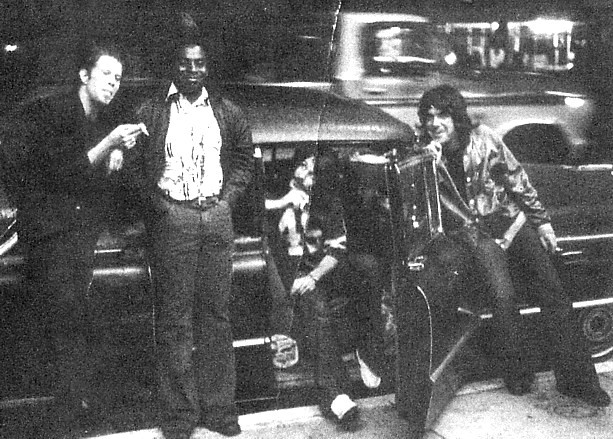
Waits's black 1954 Cadillac. With: Paul Body, Robert Marchese and Chuck E. Weiss in front of the LA Troubadour (Source: “Lowside Of The Road: A Life Of Tom Waits" by Barney Hoskyns, Faber/ Broadway, 2009. Date: ca. late 1976. Credits: courtesy of Robert Marchese)
"...In a Cadillac with Susan Michelson..." (Sub-title to "Eggs & Sausage". Nighthawks At The Diner, 1975)
"...But she used to have a sugar daddy and a candyapple Caddy. And a bank account and everything, accustomed to the finer things..." ("Invitation To The Blues". Small Change, 1976)
"...See that vulture in the Fleetwood, with the chartreuse hood. Sees you're tryin' to get your bearings. Say, 'Hey baby, which way's the main stem?'..." ("$ 29.00". Blue Valentine, 1978)
"...And you say you like his Cadillac. Says 'Honey, I got two or three. Sweetheart, you're sure fortunate that you ran into me'..." ("$ 29.00". Blue Valentine, 1978)
"...The girls around here all look like Cadillacs. And no one likes a stranger here..." ("Saving All My Love For You". Heartattack And Vine, 1980)
Tom Waits (1975): "I just blew a head gasket on this '54 Cadillac. I bought it - first car I ever bought on a car lot cause I don't know, they're all con artists, real professional grifters and I was down in Burbank on Victory and I went to this place called Jerry Lee's Used Cars. I saw this black '54 Caddy, big sucker, it's late '54 - it's the limo model and I swear it runs like a sewing machine...Right now I got this Cadillac and it's just wonderful. That was the hydramatic Dynaflow transmission and it's just lalalalaala - a wonderful automobile. I've never really compromised on comfort for economy but it loves oil, crazy about Super Shell, can't get enough of it.." (Source: "Folkscene" with Howard And Roz Larman (KPFK-FM 90.7). Los Angeles/ USA. January 12 (February 13?), 1975)
Tom Waits (1975): "I never spent more than $150 - $200 for a car. It's just against my ethics, although I did invest $300 in a 1954 black Cadillac 4 door sedan I bought at a place called Jerry Lee's Autos, from a crooked car dealer, that was just recently, I paid cash for it... Q: Do I have hobbies? TW: I work on my car at home, I got that '54 black Cadillac 4 door sedan I was telling you about. It loves gas, it's reliable, I got it parked at a friend's house under a tree. It's gonna be covered in pigeon crap by the time I get back." (Source: "WAMU radio interview", WAMU Radio Washington, DC. April 18, 1975)
Todd Everett (1975): "At home Waits drives a huge, black 1954 Cadillac which, he confesses, "costs me more than a new car probably would. I get six miles per gallon long distance; three driving around town. It eats, drips, and burns oil like crazy. It's comfortable for me though, it's roomy and I can put all my garbage in the back seat. I've always had old cars and always enjoyed Body by Fisher and other fine automotive structures." (Source: "Tom Waits: In Close Touch With The Streets" by Todd Everett. Los Angeles Free Press. October 17-23, 1975)
Tom Waits (1999): "Had a (...) '54 Caddie, black - they said it was in The Godfather, and I think I paid more for it because of that. Godfather prices, that's what they said." (Source: "The Man Who Howled Wolf" by Jonathan Valania. Magnet magazine June-July, 1999)
Lordfrench (2000) on John Stewart and Tom Waits in the mid 1970's: "Following a show at the Palomino one night in the mid '70s, Waits drove out to John and Buffy's house in his '54 Cadillac with John as his passenger. His driving was so erratic, smoking and talking and weaving as he drove, that when they pulled up at the Stewart's home, John crawled out of Waits' car on his hands and knees and kissed the ground in appreciation." (Source: Bloodlines archives Digest V2 No 97. December 7-8, 2000)
Tom Nolan (2007) on Waits living at the Tropicana, ca. 1977: "I remember seeing him outside Duke's one morning about eleven o'clock. He had this long black car parked next to the curb, and he's got the hood up and his sleeves rolled up and he's like, taking the carburator apart. It was great but it twisted your mind that somebody like that could be fixing his car right there. To do it in this theatrically natural way. He was in his own movie and you wanted to buy a ticket!" (Source: Tom Nolan interview March 15, 2007 as quoted in “Lowside Of The Road: A Life Of Tom Waits" by Barney Hoskyns. Faber/ Broadway, 2009)
1964 emerald green Ford Thunderbird (late 1970's)
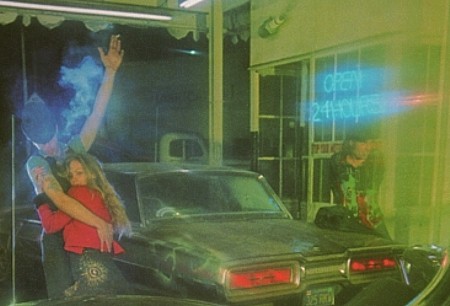
Waits's 1964 Ford Thunderbird as pictured on the cover of the album: "Blue Valentine",
released September 1978 (with Rickie Lee Jones and Chuck E. Weiss).
Credits: photography by Elliot Gilbert
"...Syphon all the gas from your daddy's pickup truck. Fill up Johnny's T-bird. I got a couple of bucks..." ("Wrong Side Of The Road". Blue Valentine, 1978)
"...Now your Uncle Emmet, well he drives a Thunderbird, it used to belong to your Aunt Evelyn. Well, she ruined it, drove it to Indiana with no gear oil. That was the end of that!..." ("The Pontiac". Smack My Crack, 1987)
Dave Lewis (1979): "Cars, in fact, are one of Waits' real passions. He sports an elaborate tattoo on his arm emblazoned with the word 'Nighthawk', which was the name of a 'car-club' he belonged to as a teenager and he can readily run off a list of the wheels he's owned, including his current emerald green '64 T-bird." (Source: "Tom Waits: A Sobering Experience" by Dave Lewis. Sounds magazine. August 4, 1979)
Cadillac (New York, 1985)
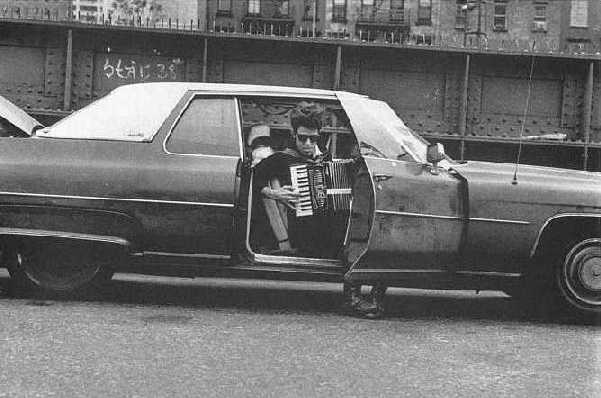
Waits and his New York Cadillac (probably a 1970's De Ville) as printed in the Rain Dogs tourbook, 1985.
Date: New York, 1985. Credits: photography by Anton Corbijn
"...Just make sure she's all in calico and the color of a doll. Wave the flag on Cadillac Day and a skillet on the wall..." ("Tango Till They're Sore". Rain Dogs, 1985)
Tom Waits (1985) on living in New York: "That's what I miss most about LA: driving. My father-in-law gave me a Cadillac. Jesus, I was towed three or four times, just crazy. $1500 worth of tickets. I had New Jersey plates, I was treated like dogmeat in this town." (Source: "Lower East Side Story" by Elissa van Poznak. The Face magazine. November 1985)
Yellow Chevrolet Citation/ Celebrity (Chicago, 1986)

The Chevrolet Citation was a compact car sold by the Chevrolet brand of American automaker General Motors (GM) for model years 1980-1985. It was Chevrolet's first front-wheel drive car. The Citation was Motor Trend magazine's Car of the Year for 1980, a decision later criticized by the staff of Car and Driver in 2009, citing that the poor build quality and mechanical reliability were not deserving of such an award in hindsight
Bill Schimmel (2007) on working with Waits for the Frank’s Wild Years play, Chicago 1986: “Schimmel has never forgotten a nightly ritual enacted by his employer. Before each performance of Frank's Wild Years, Waits would show up outside the theatre, park his yellow Chevy Citation on the opposite side of the street, and walk straight past the people lining up for tickets. Nobody, says Schimmel, ever recognized him.” (Source: Bill Schimmel interview December 12, 2007 as quoted in “Lowside Of The Road: A Life Of Tom Waits" by Barney Hoskyns. Faber/ Broadway, 2009)
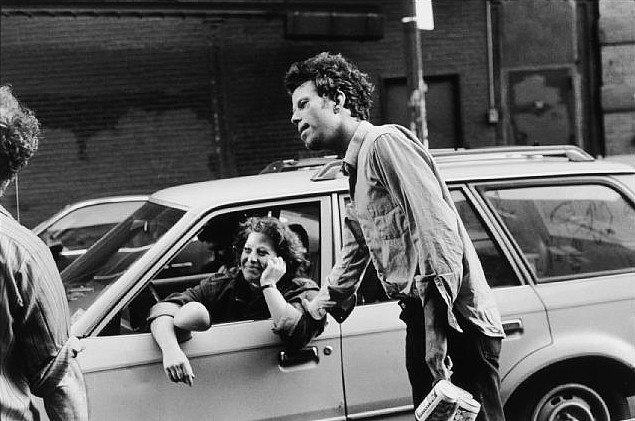
While Schimmel remembers Waits driving a Chevrolet Citation in Chicago 1986, the above picture shows Waits near, what seems to be, a 1980's Chevrolet Celebrity wagon (Date: Chicago, early 1986. Photography by Brian Graham)
The Chevrolet Celebrity was a mid-size car built by General Motors, introduced in 1981. It was the best-selling car in the United States in 1986. Celebrity production ended 1990.
1956 beige Ford Wagon (late 1980's?)

Beginning in 1955, Ford spun their station wagons into their own series. In 1956 Ford Motor Company produced several station wagons: the Parklane (1956 only), the Ranch Wagon, the Country Sedan and the Country Squire (the premium station wagon in the Ford range)
"...Here come the big black Mariah. I see the big black Ford..." ("Big Black Mariah". Rain Dogs, 1985)
"...I'm gonna watch that old horizon, for my brand new Ford, yeah..." ("Jesus Gonna Be Here". Bone Machine, 1992)
1959 Dodge Wagon (late 1980's?)
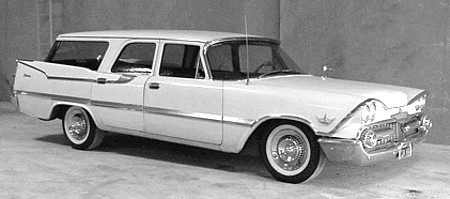
Dodge is a United States-based brand of automobiles, minivans, sport utility vehicles, and pickup trucks, manufactured and marketed by Chrysler Group LLC. Styling was not initially Dodge's strong point, though that began to change by 1953 under the direction of corporate design chief Virgil Exner. Dodge is well-known today for being a player in the muscle car market of the late 1960's and early 1970's.
"...I stood on the roof, of Stuart's old Dodge.." ("Buzz Fledderjohn". Hold On, 1999/ Orphans - Brawlers, 2006)
1964 champagne-colored Cadillac Coupe de Ville (early 1990's)
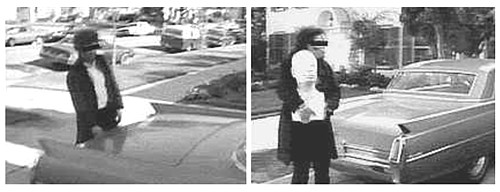
Waits and his 1964 Cadillac Coupe de Ville as featured in the promo video for "It's Alright With Me". Video directed by Jim Jarmusch, released 1990.
The Coupe de Ville (sometimes spelled Coupe Deville or Coupe DeVille) was a model of Cadillac from 1949 through 1993. The name has become famous through pop culture, with references in pop songs, movies, and other media. Cadillac De Ville nomenclature always followed a tradition: Two doors with steel roofs were always Coupe De Ville, four doors were always Sedan De Ville until the elimination of two door models, and convertibles were always simply De Ville, as they were neither a coupe, nor a sedan by design
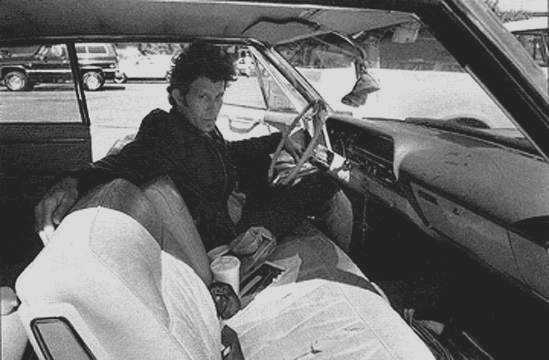
Waits in his 1964 Cadillac Coupe de Ville as printed in the book: "Beautiful Maladies", Amsco/ Jalma Music 1997.
Also printed in Straight No Chaser magazine Vol. 1 Issue 20 (UK) early 1993.
Credits: photography by Jim Jarmusch, copyright 1993
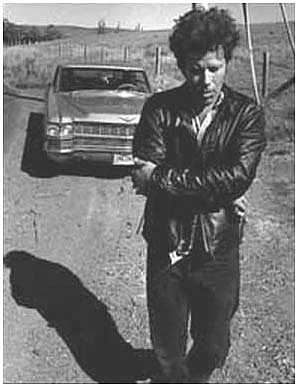
Waits and his 1964 Cadillac Coupe de Ville as printed in the book: "Beautiful Maladies", Amsco/ Jalma Music 1997.
Also printed in Straight No Chaser magazine Vol. 1 Issue 20 (UK) early 1993.
Credits: photography by Jim Jarmusch, copyright 1993
"...And the early dawn cracks out a carpet of diamonds across a cash crop car lot, filled with twilight Coupe de Villes..." ("The Ghosts Of Saturday Night". The Heart Of Saturday Night, 1974)
Tom Waits (1993): "Something we have always done as a family is what we call "going for a spin." On a dark, rainy night, we take the old Caddy out on a stretch of treacherous, curving road and get it up to about ninety and slam on the brakes. The kids scream with glee because we always end up in a different place. It's better than the Cyclone or the Tilt-A-Whirl, and best of all, we do it as a family" (Source: "Tom Foolery: Swapping Stories With Inimitable Tom Waits". Buzz Magazine (USA). May, 1993)
Mark Richard (ca. 1994): "I am sitting in the back seat of Tom Waits' Cadillac. A 1964 gold Sedan Deville. The upholstery is sprung, the floorboards are deep with superhero appendages, words-of-wisdom books, pony blankets, food things. It smells like kids and gasoline. Waits left the gas cap at a self-serve the previous night. Up in the front seat, Biff Dawes , first engineer of the Sunset Sound Factory, fiddles with the stereo system. Waits - broken porkpie hat, black jeans, and T-shirt he'll wear most the next three weeks - turns the ignition. Tonight the blue moon is so bright that people are cruising headlight less. Waits is not cruising tonight. Tonight Waits is working, mixing his latest album, and he does not trust the low end of the Sound Factory's studio speakers. A bit of the master tape has been transferred to cassette, and Dawes puts it in the system in Waits' car. No, Waits tells Dawes, he doesn't know exactly what kind of system it is, just the kind where you drive into some place, and they install it. Waits listens to most things in his car, trusts his car, tells Dawes that the car listened to "Bone Machine", Waits' last album, and the car liked the album very much. "I'm glad," says Dawes... Waits says he likes the way the cut sounds now, but just to make sure, we all slide out of the Cadillac on the passenger side because the driver's door is broken shut." (Source: "The Music Of Chance" by Mark Richard. Spin magazine (USA). June, 1994?)
Tom Waits (1999): "Had (...) a '64 Cadillac, champagne color - bought it in Montana. My wife drove it back out, no air conditioning, it was 120 degrees. She's still mad about that" (Source: "The Man Who Howled Wolf" by Jonathan Valania. Magnet magazine June-July, 1999)
1965 Chevrolet El Camino (early 1990's)
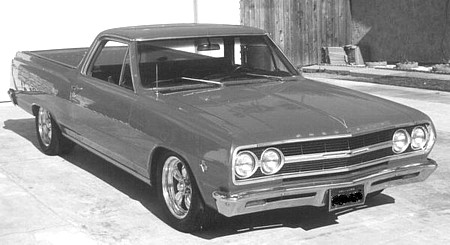
The Chevrolet El Camino is a coupe utility vehicle produced by the Chevrolet division of General Motors from 1959 through 1960, with production resuming in 1964 and continuing through 1987. El Camino was produced in response to the success of its rival Ford Ranchero. The 1965 El Camino received and attractive facelift with a veed front end similar to the redesigned full-size Chevrolets
Jim Jarmusch (1992): "The following conversations were recorded (and accompanying photographs made), during a one week period in October of 1992 in and around Tom's house, in a nearby chicken-ranch-turned-recording-studio, and most often while driving around in either Tom's 1964 Cadillac, or his '65 Chevy El Camino. Our final conversation was abruptly concluded when the El Camino literally caught on fire while we were driving it (with a full load of furniture in the back). Somehow it was an appropriate ending point for an unpredictable adventure with Tom Waits." (Source: "Tom Waits Meets Jim Jarmusch" by Jim Jarmusch. Straight No Chaser magazine (UK). October 1992, published early 1993)
1967 Cadillac Coupe de Ville (mid 1990's)
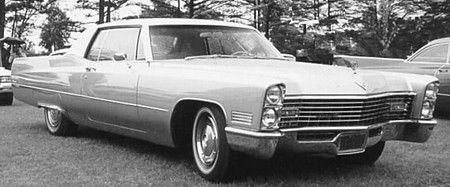
The Coupe de Ville, like other Cadillacs, grew substantially larger and more powerful from 1949 through the early 1970s. The 1967 Coupe de Villes were extensively restyled. Prominent styling features were given a powerful frontal appearance with forward-leaning front end, long sculptured body lines, and redefined rear fenders that had more than just a hint of tail fins in them. The full-width forward-thrusted "eggcrate" grille was flanked by dual stacked headlights for the third consecutive year. Rectangular parking lamps were built into the outer edges of the grille
Barney Hoskyns (1999): "Waits climbs into the 1970 Coupe de Ville a replacement, he informs me, for a 1967 model he totalled last year. ("I'm not hurt," he protested when his son Casey saw him staunching a head wound with a McDonald's takeout bag. Fortunately for Waits Sr, Casey begged to disagree)" (Source: "Mojo Interview With Tom Waits" by Barney Hoskyns. Mojo magazine (USA), Santa Rosa. April, 1999)
1970 blue Cadillac Coupe de Ville (late 1990's)
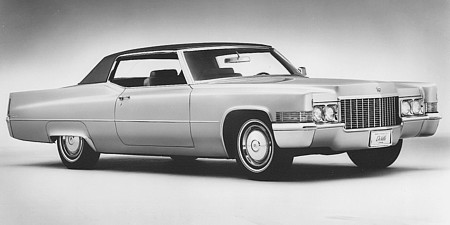
Although sales on the handsomely restyled 1965 Coupe de Ville set yet another record for this popular body style, it took second place to the companion four-door hardtop Sedan de Ville. The 1970 Coupe de Ville had a redesigned grille and horizontal headlight pairs. The Coupe de Ville remained a pillarless hardtop, but for 1974 was restyled as a pillared two-door with then-fashionable opera windows behind the side windows
1972 white Chevrolet Suburban (late 1990's)
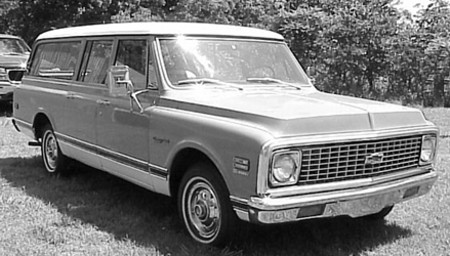
The Suburban is a large sport utility vehicle from Chevrolet. It is the longest-lived continuous automobile nameplate still in production, dating from 1935. Many automotive companies in the United States used the "Suburban" name to indicate a windowed, station wagon type body on a commercial frame including Dodge, Plymouth, Studebaker, Nash, Chevrolet, and GMC. With the end of production of the Dodge Town Wagon in 1966 and the Plymouth Suburban station wagon, only General Motors continued to manufacture a vehicle branded as a "Suburban", and they were awarded an exclusive trademark on the name in 1988. The second generation C/K Suburbans (1967-1972) are easily recognised by having only a single drivers side door and two passenger-side doors
Tom Waits (1999): "I got a '72 white Suburban that no one in the family will ride in. My vehicles have always been humiliating for the kids. This one, it's like a motel, and they even complain about this. I say, "You're nuts. You could live in this car!" Q: A family of five. TW: Comfort. Roadability. Reliability -- hence the name "Old Reliable." Smoked windows. For anonymity. 'Cause there's times when you just want to sneak in, do your business and sneak out" (Source: "Gone North, Tom Waits, upcountry" by Robert Lloyd. L.A. Weekly: April 23-29, 1999)
black Chevrolet Silverado (late 1990's)
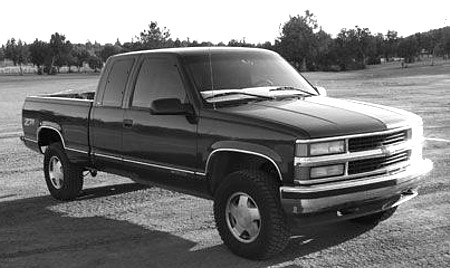
A 1998 Chevrolet Silverado 1500LT
General Motors designated the term "Silverado" to detail the higher-level trim for the Chevrolet C/K pickup trucks from 1960 through 1999. The Chevrolet Silverado (and GMC Sierra trucks) have been essentially the same for their entire history. In 2007 Chevrolet began a multi-media marketing campaign to support the Silverado full-size pickup, which featured the tag line "Our Country. Our Truck"
Robert Lloyd (1999): "Driving me back to my hotel in the big black Silverado he calls (today, at least) Old Reliable, Waits detours to a flower-bedecked makeshift roadside shrine dedicated to the memory of 12-year-old Georgia Lee Moses, the subject of "Georgia Lee," a lilting Irishy lullaby on Mule Variations." (Source: "Gone North: Tom Waits, Upcountry" by Robert Lloyd. L.A. Weekly, Santa Rosa. April 23-29, 1999)
1985 black Chevrolet Suburban (late 1990's/ early 2000's)
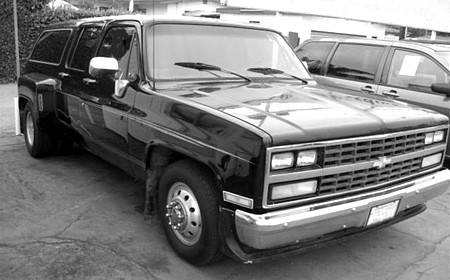
With the third generation C/K models, the Suburban became a 4-door vehicle. The rounded 1970s body style remained largely unchanged for 18 model years - making this series the longest in production of any Suburban. Trim options included base level, and upgraded Silverado versions. An optional 3rd row bench seat allowed for 9-passenger configurations. A rear heating system was optional, as well, to help heat the long vehicle's interior
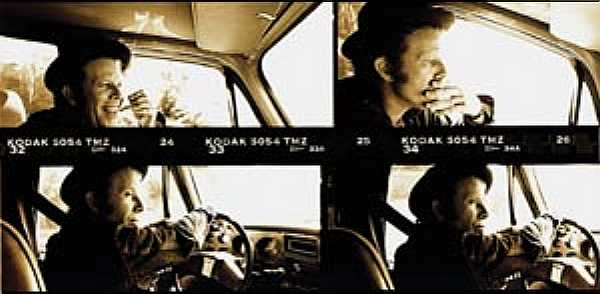
Waits behind the wheel of his 1985 black Chevrolet Suburban.
Date: Magnet Magazine, 1999. Credits: photography by Christian Lantry
Mark Linkous (2006) on meeting Waits for the first time, ca. 1999: "The first time Linkous was given Tom Waits's phone number he had to knock back five shots of whisky and lock himself in a room before he felt brave enough to make the call. He finally went to California to meet Waits. "He told really great stories. He also scared me to death. We were driving down the highway in his big suburban SUV talking about animals we disliked. I mentioned carrion-eating turkey buzzards. He doesn't like them either. He proceeded to do an impression of a turkey buzzard sunning itself, his arms outstretched as we were flying down the highway at 80mph" (Source: "I think I kind of blew it", The Guardian. September 29, 2006)
Jonathan Valania (1999): "Arriving at the Astro, Waits pulls up in a 1985 Suburban, an unlikely ride for a man known for driving cars made before Kennedy was assassinated. "I refuse to call it a Suburban - I call it a Bourbon," he says" (Source: "The Man Who Howled Wolf" by Jonathan Valania. Magnet magazine June-July, 1999)
1959/ 1960 4-door Cadillac De Ville (early 2000's)
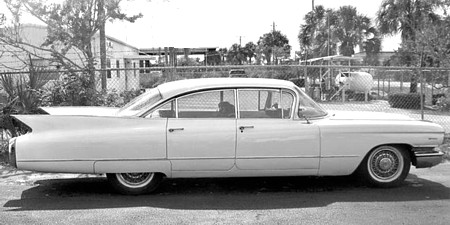
A 1960 4-door Cadillac De Ville (62 series)
In 1956 the Cadillac Coupe deVille was joined by the Sedan deVille, a four-door hardtop sedan. The Sedan deVille would ultimately outlive its two-door predecessor. Cadillac De Ville nomenclature always followed a tradition: Two doors with steel roofs were always Coupe De Ville, four doors were always Sedan De Ville. Further, from the beginning and for many years, De Ville denoted an option package on the basic car (called Series 62, later Calais), not the body style. In other words, you could have a four-door Cadillac that was not a Sedan De Ville, nor would it have such lettering on the flanks of the car. In 1959 the DeVille line was redesigned and separated in a distinct Series 63. The new model featured full fender skirts and a sleeker front end. The first Cadillac 4-door hardtop version appeared in 1956. T he Coupe de Ville 1959-1964 generation, like other Cadillacs, grew substantially larger and more powerful from 1949 through the early 1970's
"...29 gypsies in a Cadillac stoned. Turn off the ringer on your cellular phone..." ("Metropolitan Glide". Real Gone, 2004)
Keith Phipps (2002): "What are you driving these days? TW: Oh, I got a beautiful 1959 Cadillac Coupe DeVille four-door. No one will ride in it with me. O: Why's that? TW: It's unsafe. But it looks good. I take it to the dump. We spend a lot of time in our cars. You know what I really love? The CD players in a car. How when you put the CD right up by the slot, it actually takes it out of your hand, like it's hungry. It pulls it in, and you feel like it wants more silver discs. "More silver discs. Please." I enjoy that. O: Do you have one in the Cadillac? TW: No, I have a little band in there. It's an old car, so I have a little old string band in the glove compartment. It's grumpy" (Source: "Tom Waits" by Keith Phipps. The Onion A.V. Club online magazine (USA). May 29, 2002)
4x4 Lexus (2004)
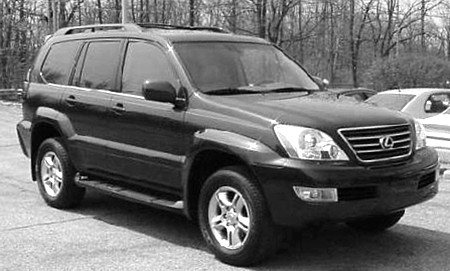
A 2004 Lexus GX470 AWD
Lexus is the luxury vehicle division of Japanese automaker Toyota Motor Corporation. It was first introduced in 1989 in the United States, where Lexus has ranked as the highest-selling maker of luxury cars. From the start of production, Lexus vehicles have been consistently produced in Japan. Since 1989, Lexus has developed a reputation for vehicle reliability and customer service, as measured by independent surveys. In May 1995, sales were threatened by the U.S. government's proposal of 100 percent tariffs on Japanese luxury cars in response to the widening U.S.-Japan trade deficit. Normal sales operations resumed a month later when the Japanese auto manufacturers collectively agreed to greater American investments, and the tariffs were not enacted.
More auto brand names in lyrics:
"...Well, this reminds me of the time. We were drinkin' Red Mountain wine. In the back of a Volkswagen bus..." ("Tijuana". w. Jack Tempchin, 1973)
"...Well, you gassed her up, behind the wheel. With your arm around your sweet one, in your Oldsmobile .." ("The Heart Of Saturday Night". The Heart Of Saturday Night, 1974)
"...Duster tryin' to change my tune. Pullin' up fast on the right.." ("Diamonds On My Windshield". The Heart Of Saturday Night, 1974)
"...Let me put the cut back in your strut and the glide back in your stride. Now climb aboard a customs Oldsmobile, let me take you for a ride'..." ("Nighthawk Postcards". Nighthawks At The Diner, 1975)
"...Well, I think it's about time I took you on an improvisational adventure into the bowels of the Metropolitan region. Looks like a bona fide high voltage decked out in full regalia Angelino audience, driving in Subarus, Pintos, Malibus, Oldsmobiles..." ("On A Foggy Night" intro. Nighthawks At The Diner, 1975)
"...And the parking lot attendants leave the money in the drawer. And take that Corvette Stingray with a four-on-the-floor..." ("A Nickel's Worth Of Dreams". Foreign Affairs sessions, July - August 1977)
"...And baby, I saw you in nineteen fifty-seven. Nineteen fifty-seven in a Lincoln Continental with Rhode Island plates, passing me on Route 66 doing seventy-five miles an hour..." ("Just Another Dime Store Novel". Foreign Affairs sessions, July - August 1977)
"...And the spider web crack and the Mustang screamed. The smoke from the tires and the twisted machine..." ("Burma Shave". Foreigh Affairs, 1977)
"...Without fear of contradiction, bon voyage is always hollered in conjunction with a handkerchief from shore, by a girl who drives a Rambler and furthermore is overly concerned that she won't see him anymore..." ("Foreign Affair ". Foreigh Affairs, 1977)
"...Neal was yellin' out the window, tryin' to buy some bennies from a Lincoln full of Mexicans, and the left rear tire blowed..." ("Jack & Neal". Foreigh Affairs, 1977)
"...and now they're huddled in the brake lights of a '58 Bel Air and listenin' how Romeo killed a sherif with his knife..." ("Romeo Is Bleeding". Blue Valentine, 1978)
"...I drive a Chevy, not a goddamn Ford!..." ("Whose Sports Coat Is That?". 1979 live versions, no official release)
"...Droopy Stranger, Lonely Dreamer, Toy Puppy and the Prado were laughin' as they piled into Olmos' Eldorado..." (''Til The Money Runs Out". Heartattack And Vine, 1980)
"...Well, I slept in the holler of a dry creek bed. And I tore out the buckets from a red Corvette..." ("16 Shells From A Thirty-Ought-Six". Swordfishtrombones, 1983)
"...Well, he came home from the war with a party in his head. And a modified Brougham DeVille..." ("Swordfishtrombone". Swordfishtrombones, 1983)
"...And I built a fire in the skeleton back seat of an old Tucker..." ("Trouble's Braids". Swordfishtrombones, 1983)
"...Blew a hole in the hood of a yellow Corvette. A hole in the hood of a yellow Corvette..." ("Gun Street Girl". Rain Dogs, 1985)
"...Well, my parole officer will be proud of me. With my Olds '88 and the devil on a leash" ("Goin' Out West". Bone Machine, 1992)
"...She drove a big ol' Lincoln with suicide doors and a sewing machine in the back..." ("Thousand Bing Bangs". Devout Catalyst, 1992/ "First Kiss". Orphans - Bastards, 2006)
"...Punctuated birds on the power line. In a Studebaker with Birdie Joe Hoaks..." ("Get Behind The Mule". Mule Variations, 1999)
"...Black joke and the bean soup. Big sky and the Ford Coupe..." ("Top Of The Hill". Real Gone, 2004)
"...Why don' cha gimme 'nother sip of your cup. Turn a Rolls Royce into a Chicken Coup..." ("Top Of The Hill". Real Gone, 2004)
"...My baby went and left me in a '49 Ford. Going down the highway in a 49 sword..." ("Baby Gonna Leave Me". Real Gone, 2004)
"...Big ol' Lincoln with the suicide doors..." ("Putting On The Dog". Orphans - Brawlers, 2006)
"...Israel sent 4 choppers in, flames engulfed his white Opel. And it killed his wife and his 3-year-old child, leaving only blackened skeletons..." ("Road To Peace". Orphans - Brawlers, 2006)

